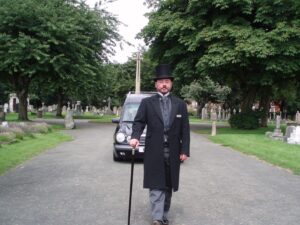
W H Auden’s famous poem Funeral Blues starts with the line Stop all the clocks.. and also speaks of muffled drums, putting crepe bows round the white necks of the public doves and letting the traffic policemen wear black cotton gloves (instead of their customary white ones). But have you ever wondered why it was customary to stop clocks or wear black for a funeral? Or why refreshments after a funeral are known as a wake? Or where the expression “saved by the bell” comes from?
We need to travel back in time, to the 14th of December 1861 for an answer. A death occurred which changed the way England mourned and began a whole new era of funeral mourning and rituals. For it was on this day that Prince Albert, husband and Consort of our then Queen, Victoria, died of typhoid.
The Queen was inconsolable. Her diaries detailed the depth of her grief – “to be cut off in the prime of life.. when I had hoped with such instinctive certainty that God never would part us and would let us grow old together.. is too awful, too cruel!” She instructed Albert’s rooms in each of their houses be kept unchanged as if waiting for him to return, she built monuments to him and wore black in mourning for the rest of her life.
Victorian Life
It has to be remembered that, in Victorian times, things were very different. Infant mortality was extremely high and life expectancy considerably lower than it is today. Most people died at home and so it was a natural part of life to not only see death, but also the care of the body after death. A wreath, symbolising victory over death and usually made of laurel, yew or boxwood and tied with black crepe, would be hung on the front door so everyone would know that a death had occurred.
Superstition and Rituals
Mixed with these public signs of mourning were the traditions and rituals steeped in superstition. Clocks would be stopped at the time of death to ward off further back luck, curtains would be closed and mirrors were either draped with black cloth or turned to the wall so the spirit of the deceased could not get caught in them. Sometimes family photographs would also be turned face-down to prevent any of the close relatives and friends of the deceased being possessed by the spirit of the dead. It was considered taboo to speak ill of the dead for fear that, if people did behave in such a disrespectful way, the dead would be able to return from the grave to haunt them and bring bad luck.
Care of the Deceased
The deceased was usually cared for at home in the parlour room – the front room of the house kept for best and rarely used except for special occasions. The body would be washed and dressed, usually by a friend of the family, and would be watched over for a few days until burial – hence the term “waking”. The wake was important in ensuring that the person really was dead and not merely unconscious. Such was the fear of being buried alive that the deceased were sometimes buried with a rope in their hand, which was attached to a bell outside of the grave. Therefore, if the person in the coffin came to, they could ostensibly ring the bell to summon assistance – hence “saved by the bell.”
The tradition of fresh flowers stemmed from a time before embalming and would be placed to help conceal the smell of decay. In addition, the coffin would often be positioned on a cooling board with crates of ice underneath the body. When the deceased left the house, they would be carried out feet first – Victorian superstition decreeing that if carried out head first, the spirit might persuade the living to come with them into death.
Undertakers and Funeral Directors
The term “undertaker” comes from the person who “under took” charge of funeral arrangements and the deceased. Victorian England also saw the rise of more elaborate funerals for the wealthy and middle classes and the introduction of the Funeral Director. For the wealthy, the burial of a loved one was as much about appearances and things being done correctly with due reverence to the deceased as it was about the process of grief and mourning. Professional mourners could be hired to follow the hearse looking bereft and impressive processions complete with glass viewing coffins, black horses and ostrich feathers were not uncommon.
The funeral director would page or lead the funeral procession from the deceased’s house to the church on foot, accompanied by the pall bearers who would flank the hearse. A cane or stick was often carried to discourage stray dogs from startling the horses or impeding the progress of the procession. This tradition of paging in front of the hearse is still continued today – not only as a mark of respect but also to symbolise the last time that the deceased leaves their home.
What Do You Think?
Funerals and the traditions and etiquette associated with them continue to evolve and much has changed since Victorian times but some of those marks of respect, such as paging and bowing to the hearse, continue. How do you think that funerals could change for the better and what traditions do you think should still continue?